The QoF in documenta fifteen
Or how do we work between localities?
مسألة التمويل في دوكيومنتا ١٥
أو كيف نعمل في المجتمعات المحلية؟
Since we were a very young collective when documenta approached us to take part in its fifteenth edition and despite our initial hesitations to commit to such an endeavor, the projects we presented there reflect both the conceptual and theoretical vectors that emerged from our ongoing debates and discussions on the question of funding, economic infrastructures, as well as knowledge production.
Our presence in documenta fifteen took the form of four different aspects that were activated in various ways both locally in Kassel and beyond the framework of the 100 days of the exhibition.
The lumbung, which brought together hundreds of collectives and thousands of individuals both before and during documenta fifteen, proposed a unique structure within which we deployed our processes, invited friends and collaborators, and thought and worked together around issues at the core of our processes, invited friends and collaborators, and thought and worked together around issues at the core of our practice.
بما أننا كنّا مجموعة شابّة للغاية عندما دُعينا للمشاركة في النسخة الخامسة عشرة من Documenta 15، وعلى الرغم من ترددنا في البداية في الالتزام بهذا المسعى، فإن المشاريع التي قدّمناها هناك تعكس مجموعة من الموجّهات المفاهيمية والنظرية التي انبثقت من مناظراتنا ومناقشاتنا المستمرة حول مسألة التمويل، والبنى التحتية الاقتصادية، ناهيك عن إنتاج المعرفة.
اتّخذَ تواجدُنا في دوكيومنتا ١٥ هيئة أربعة جوانب متنوعة جرى تفعيلها بطرق مختلفة محليّاً في كاسل وتخطّت إطار مئة يوم من المعرض.
اقترحت لومبونغ التي جمعت مئات المجموعات والآلاف من الأفراد قبل وأثناء دوكيومنتا ١٥ هيكلًا فريدًا وزّعنا فيه عملياتنا ودعونا الأصدقاء والمتعاونين، وفكّرنا وعملنا معاً حول المسائل التي تقع في صميم ممارستنا.
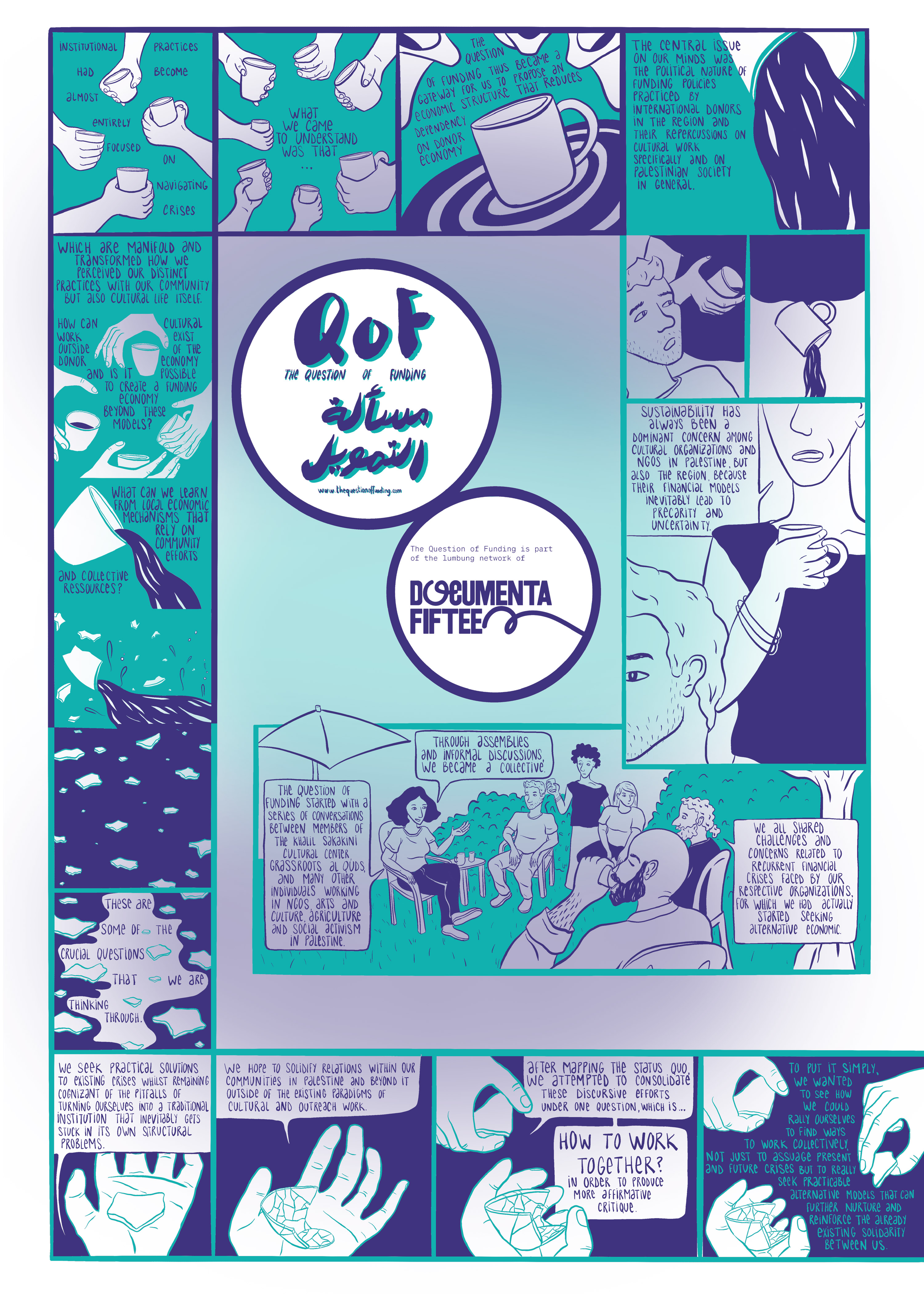
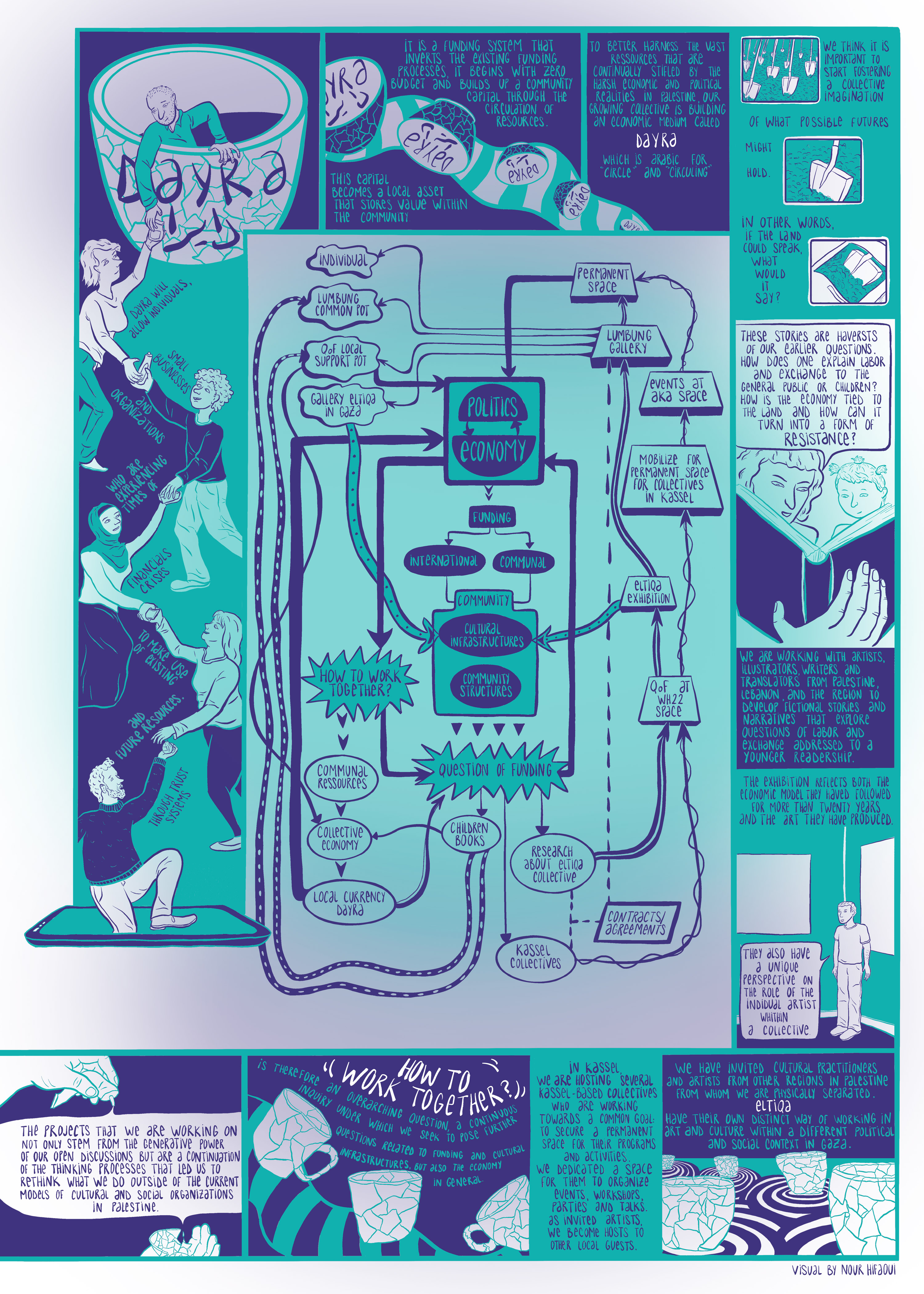
Poster by Nour Hifaoui
Welcome to Aka
Or how to connect to a context?
As a collective in the lumbung and in documenta fifteen, we wanted to work against the usual patterns imposed by big artistic institutions and biennials that typically invite artists and cultural workers to produce works, exhibit them and swiftly leave without having engaged the city and its residents.
In the spirit of the lumbung, we opened one of our spaces in documenta fifteen to other local collectives who were working on their diverse projects and within their own communities. As such, we engaged in long discussions with several Kassel-based collectives and organizations who shared a common goal: to secure a permanent space for their programs and activities. In WH22, the abandoned building we shared with other documenta fifteen artists, they came together to create aka, a decentralized network of self-organizing and grassroots collectives and open space for concerts, workshops, performances, exhibitions, discussions, and more.
As invited artists, we become hosts to other local guests. They host their activities in our space and we use their space to host our own. The connection with aka extends the map of relations, almost like ripples in a pond that widen the circles of individuals, ideas, and potentials.
As invited artists, we became hosts to other local guests. They host their activities in our space and we used their space to host our own. The connection with aka extends the map of relations, almost like ripples in a pond that widen the circles of individuals, ideas, and potentials.
Since December 2022, a few months after documenta fifteen ended, aka have officially become the tenants of WH22, in the hope that they will use and rent the rest of the area in Spring 2023. While the city of Kassel will provide financial support, aka will remain independent and decide how best to use the space and its surroundings. After some time to reflect and develop, aka still hopes that their collective structure will be able to buy WH22 collectively.
أهلا بكم في aka
أو كيف تتصلون بسياق ما؟
أردنا كمجموعة مشاركة في اللومبونغ وفي دوكيومنتا ١٥ العملَ ضد الأنماط المعتادة التي تفرضها المؤسسات الفنية الكبيرة والبيناليات التي عادةً ما تدعو الفنانين والعاملين في المجال الثقافي لإنتاج الأعمال وعرضها والمغادرة على جناح السرعة دون إشراك المدينة وسكانها.
بروحية مستلهمة من اللومبونغ، فتحنا واحدة من مساحاتنا للمجموعات المحلية الأخرى التي كانت تعمل على مشاريعها المتنوعة وفي قلب مجتمعاتها الخاصة. شاركنا على هذا النحو في نقاشات طويلة مع العديد من التجمعات والمنظمات التي تتخذ من مدينة كاسل مقراً لها والتي تتقاسم هدفاً مشترَكاً: تأمين مساحة دائمة لبرامجها وأنشطتها. في WH22 المبنى المهجور الذي تقاسمناه مع خمسة عشر فنانًا آخرين من دوكيومنتا ١٥، اجتمع الكلّ لخلق aka، وهي عبارة عن شبكة لامركزية من التنظيم الذاتي والقواعد الشعبية ومساحة مفتوحة للحفلات الموسيقية وورش العمل والعروض الفنّية والمعارض والنقاشات وما يتعدّاها.
بصفتنا فنانين مدعوين، غدونا مضيفِين لضيوف محليين آخرين، كان أن استضافوا أنشطتهم في مساحتنا واستخدمنا مساحتهم لاستضافة أنشطتنا. يمتد الارتباط بـ "aka" إلى خريطة العلاقات بأسرها، وهو أشبه بموجات في بركة توسّع دوائر الأفراد والأفكار والإمكانيات.
منذ كانون الأول (ديسمبر) ٢٠٢٢، أي بعد بضعة أشهر من انتهاء دوكيومنتا ١٥، أصبحت أكى رسميًا هي المستأجِرة لـWH22، على أمل أن تستخدم وتستأجر ما تبقّى من المساحة في ربيع ٢٠٢٣. بينما تتكفل مدينة كاسل بالدعم المالي، ستبقى أكى مستقلة وتبحث في اقرار أفضل السبل لاستخدام المساحة والمناطق المحيطة بها. بعد قليل من الوقت في التفكير والتطوير، لا تزال aka تأمل أن يتمكن هيكلها الجماعي من شراء WH22 بشكل تشاركي.
The 7 principles of aka are:
aka is a decentralized network.
a collective of collectives from Kassel.
aka is a medium.
we understand aka as a practice and a tool in order to establish a solidarity network among local communities.
aka is a space towards a space.
there is a need for spaces for grassroots movements in Kassel. aka uses WH22 to actively establish such a space in the city.
aka is lumbung.
aka is based on the principle of communality: pooled collective ideas, knowledge, funding and other shareable resources.
aka is based on (un)common grounds.
how do we practice our diversity and our (dis)agreements?
aka is an economy.
a solidarity economy which benefits collectives, individuals and bigger communities. It’s based on non-commercial principles and collective decision making.
aka is a host. aka is a guest.
a host and a guest. a guest and a host. QoF invites aka, aka invites QoF.
aka is a decentralized network.
a collective of collectives from Kassel.
aka is a medium.
we understand aka as a practice and a tool in order to establish a solidarity network among local communities.
aka is a space towards a space.
there is a need for spaces for grassroots movements in Kassel. aka uses WH22 to actively establish such a space in the city.
aka is lumbung.
aka is based on the principle of communality: pooled collective ideas, knowledge, funding and other shareable resources.
aka is based on (un)common grounds.
how do we practice our diversity and our (dis)agreements?
aka is an economy.
a solidarity economy which benefits collectives, individuals and bigger communities. It’s based on non-commercial principles and collective decision making.
aka is a host. aka is a guest.
a host and a guest. a guest and a host. QoF invites aka, aka invites QoF.
المبادئ السبعة لـ أكى هي:
أكى شبكة لامركزية.
تشكيل جماعي من تشكيلات جماعية في كاسل.
أكى وسيط.
نفهم aka كممارسة وأداة في سبيل خلق شبكة تضامن بين المجتمعات المحلية.
أكى فضاء نحو فضاء.
ثمة حاجة لمساحات مخصّصة لتحركات القواعد الشعبية في كاسل. تستخدم أكى WH22 لإنشاء مثل هذه المساحة بفعالية في المدينة.
أكى هي لومبونغ
ترتكز أكى على مبدأ الجماعة المشترَكة: الأفكار الجماعية المؤتلفة والمعرفة والتمويل والموارد الأخرى القابلة للمشاركة.
ترتكز أكى على أسس (غير) مشتركة.
كيف نمارس تنوّعنا و(عدم) وئامنا؟
أكى هي نوع من الاقتصاد.
اقتصاد تضامني تستفيد منه الجماعات والأفراد والمجتمعات الأكبر. إقتصاد قائم على المبادئ غير التجارية واتخاذ القرارات الجماعية.
ترتكز أكى على مبدأ الجماعة المشترَكة: الأفكار الجماعية المؤتلفة والمعرفة والتمويل والموارد الأخرى القابلة للمشاركة.
ترتكز أكى على أسس (غير) مشتركة.
كيف نمارس تنوّعنا و(عدم) وئامنا؟
أكى هي نوع من الاقتصاد.
اقتصاد تضامني تستفيد منه الجماعات والأفراد والمجتمعات الأكبر. إقتصاد قائم على المبادئ غير التجارية واتخاذ القرارات الجماعية.
أكى مُضيف. أكى ضيف.
مُضيف وضيف. ضيف ومُضيف. مسألة التمويل تدعو أكى و أكى أيضًا تدعو مسألة التمويل.
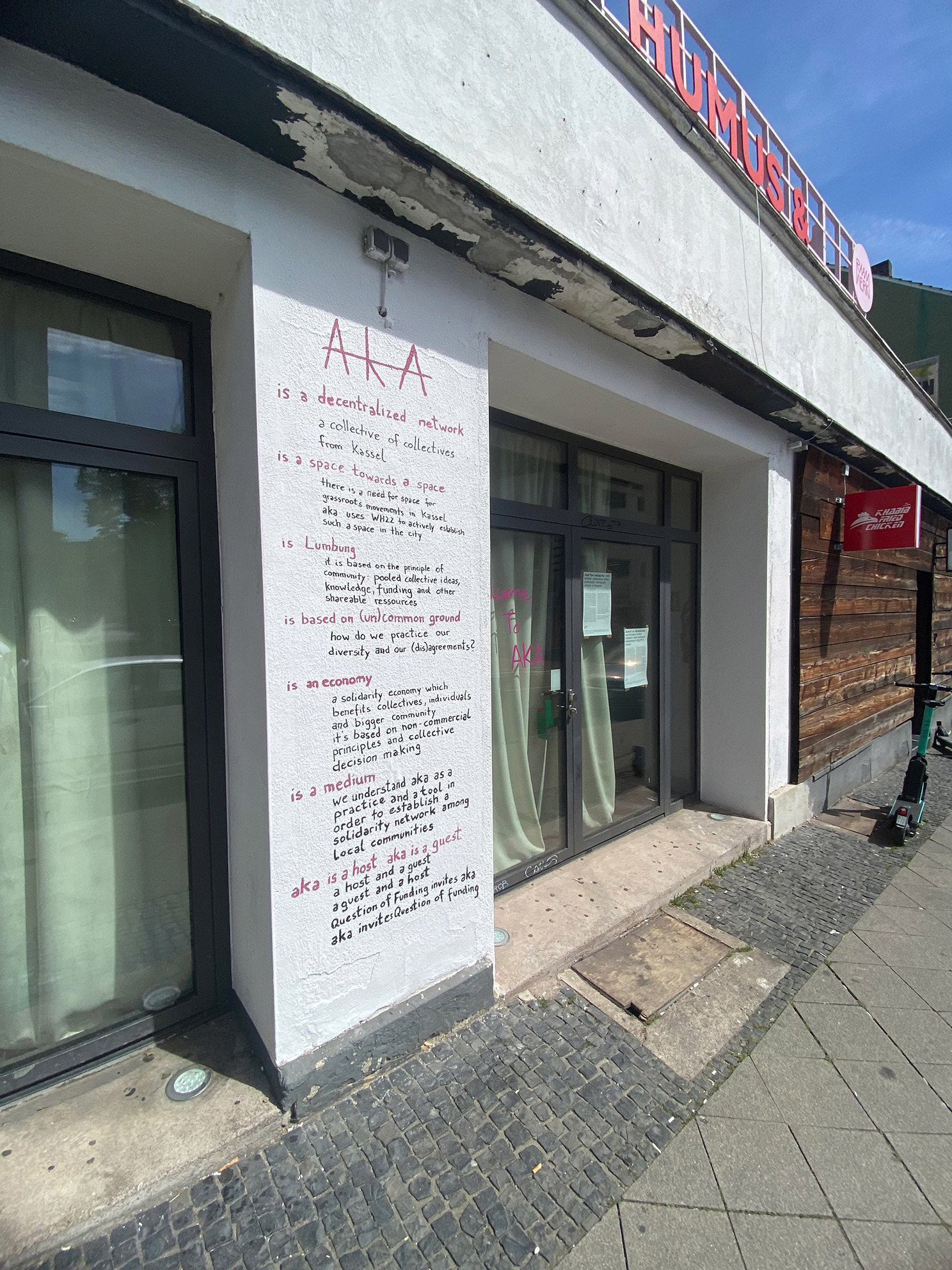
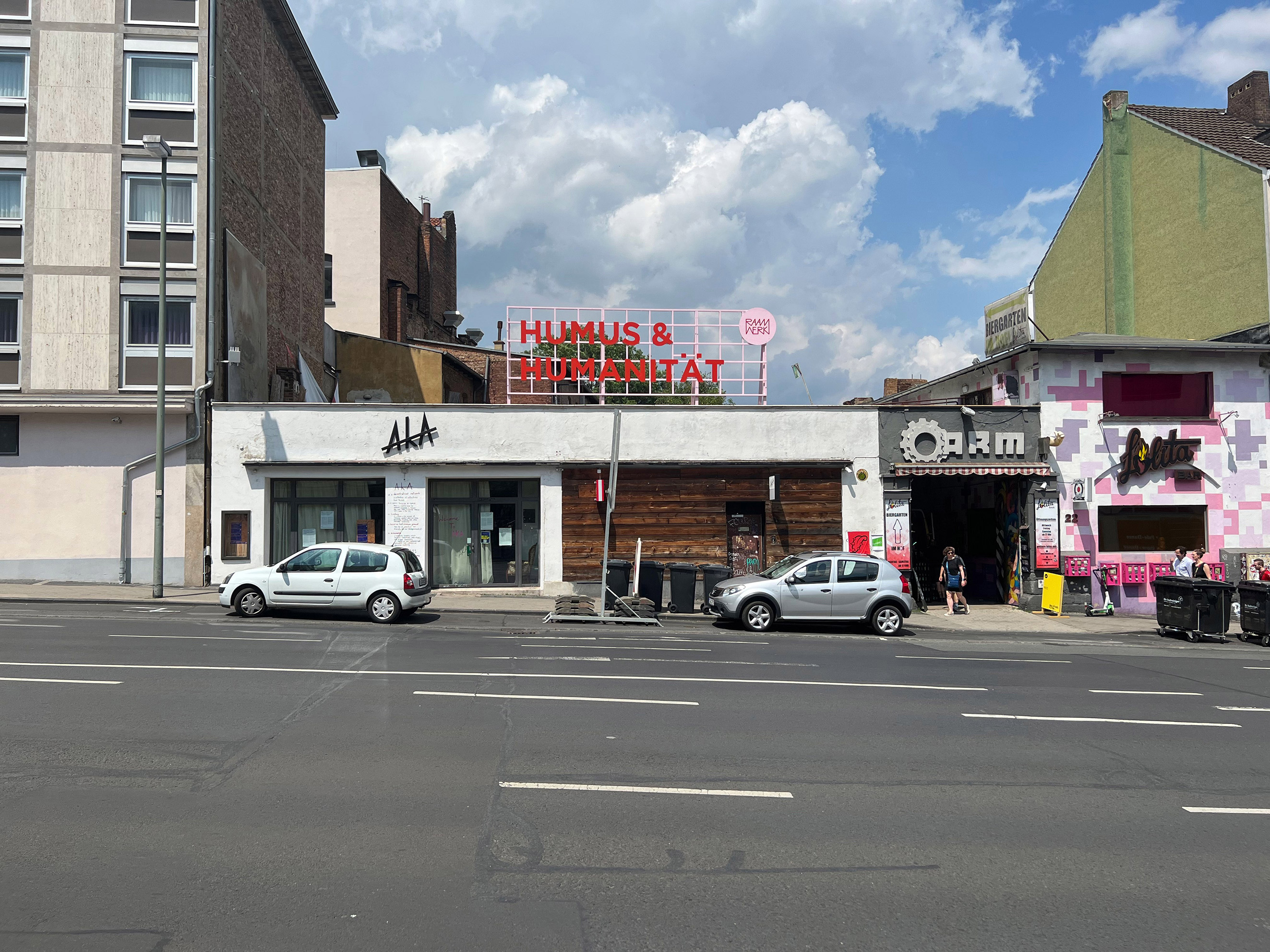
Jam on Jam on Jam on Jam
Collectivity of collective sounds or how to jam together?
During documenta fifteen’s opening week, we invited the study group JamOnJamOnJamOnJam, which is composed of artists from the Global South and based in Amsterdam. JamOnJamOnJamOnJam is a series of jamming/gathering through sonic exchange by several residents on Radio Alhara. It started in the middle of lockdown in 2020 when the artists’ shared acoustic space became less accessible, this activity aimed to share the joy of jamming with friends and family beyond the acoustic space where the jamming takes place. Much like Radio Alhara, JamOnJamOnJamOnJam also serves as a temporary communal space to exercise active listening/listened, hosting/hosted, resonating/resonated, transmitting/transmitted, to jam on jam on jam on jam.
Over three days, JamOnJamOnJamOnJam hosted talks and had music jams in aka’s space. You can listen back to the audio recordings of all three days on Mixcloud.
Collectivity of collective sounds or how to jam together?
During documenta fifteen’s opening week, we invited the study group JamOnJamOnJamOnJam, which is composed of artists from the Global South and based in Amsterdam. JamOnJamOnJamOnJam is a series of jamming/gathering through sonic exchange by several residents on Radio Alhara. It started in the middle of lockdown in 2020 when the artists’ shared acoustic space became less accessible, this activity aimed to share the joy of jamming with friends and family beyond the acoustic space where the jamming takes place. Much like Radio Alhara, JamOnJamOnJamOnJam also serves as a temporary communal space to exercise active listening/listened, hosting/hosted, resonating/resonated, transmitting/transmitted, to jam on jam on jam on jam.
Over three days, JamOnJamOnJamOnJam hosted talks and had music jams in aka’s space. You can listen back to the audio recordings of all three days on Mixcloud.
Jam on Jam on Jam on Jam
تجميع الأصوات الجماعية أو كيفية التشويش معًا؟
تجميع الأصوات الجماعية أو كيفية التشويش معًا؟
قمنا خلال الأسبوع الافتتاحي لـ documenta 15، بدعوة مجموعة JamOnJamOnJamOnJam المؤلَّفة من فنانين من جنوب العالم ومقرها أمستردام. JamOnJamOnJamOnJam هي سلسلة قائمة على التجمع/العزف الجماعي من خلال التبادل الصوتي الذي قام به العديد من المشاركين في راديو الحارة. بدأ النشاط في منتصف فترة الحجر الصحّي في عام ٢٠٢٠ عندما غدا الوصول إلى المساحة الصوتية المشتركة للفنانين أقل سهولة، وكان يهدف إلى مشاركة متعة العزف مع الأصدقاء والعائلة خارج المساحة الصوتية المخصصة عادًة للعزف. كما راديو Alhara، يعمل JamOnJamOnJamOnJam أيضًا كمساحة مشتركة مؤقتة لممارسة السماع والإستماع، والإستضافة والإضافة، والتردد والتحويل والتحول من وإلى.
على مدى ثلاثة أيام ، استضافت مجموع JamOnJamOnJamOnJam محادثات وعزف موسيقي جماعي في فضاء aka. يمكنكم الاستماع مرّة أخرى إلى التسجيلات الصوتية للأيام الثلاثة كاملة على Mixcloud.

Hosting Eltiqa
Or what economic models can we learn from?
Eltiqa (Arabic for “meeting”) is an artist collective from Gaza city. For more than twenty years, they have developed artistic practices together and have extended their resources and knowledge to younger generations. What distinguishes Eltiqa as a collective are the flexible, creative, and responsive natures of their economic model, which helped the group to sustain itself through years of political, economic, and cultural struggles.
The group diversified its economic resources and responded in agility with the changing international funding landscape in Gaza. At times they relied on self-funding their project through selling their artworks, at other times they would rely on support from individuals and friends as well as external institutional funding bodies, many times combining those different survival mechanisms. When funding was not possible, they continued to run workshops themselves for younger artists depending on their own experience as resources. Many of the members of the group work full-time and part-time jobs in teaching and other fields and the members’ contribution to Eltiqa is volunteer-based. In a way, Eltiqa sustained their independence and sustainability, in the utmost way possible; without transforming Eltiqa into an institution, an NGO, or a commercial art entity. In this sense, inviting Eltiqa to be part of QoF was crucial to learn from, in order to disseminate their knowledge and expertise in working together and inventing their own economic model in one of the most unstable environments in the world.
In collaboration with them, the exhibition includes a selection of their artworks and photographs and an annotated timeline of their activities which we collected during our interviews with them. Through anecdotes collected by QoF, the timeline accentuates the different layers of their work and their practice’s correlation with political, social, economic, and personal stories. This is juxtaposed with the aesthetics of their artistic practice.
Eltiqa is formed by a group of seven artists: Mohammed Al Hawajri, Mohamed Abusal, Dina Matar, Rauf Alajouri, Raed Issa, Mohammed Dabous, and Sohail Salem who also have their individual art artistic practices to sustain along with the platform for younger artists they have created. Since 2002, the group has participated in many exhibitions locally and internationally; such as: ‘Gaza Seasons’ at L’Olivier Library in Geneva in 2007, ‘Eltiqa’s Summer’ at the Palestinian Red Crescent Society in Gaza in 2009, supported by the French Consulate in Jerusalem, and ‘Eltiqa in Ramallah’ in 2011 at Khalil Sakakini Cultural Center, and at Galerie Arcima in Paris in 2010.
استضافة إلتقاء
أو أي النماذج الاقتصادية يمكننا التعلّم منها؟
"التقاء" مجموعة فنانين من مدينة غزة، ولأكثر من عشرين عاماً، طوّر فنانو وفنانات التقاء ممارسات فنية معاً ووسّعوا رقعة مواردهم ومعرفتهم لتصل إلى الأجيال الشابة. ما يميز التقاء كمجموعة هي الطبائع المرنة والإبداعية والمتجاوبة لنموذجها الاقتصادي، وهو ما ساعد المجموعة في الحفاظ على نفسها خلال سنوات من النضالات السياسية والاقتصادية والثقافية.
حرصت المجموعة على تنويع مواردها الاقتصادية واستجابت بمرونة مع مشهد التمويل الدولي المتغير في غزة. إذ اعتمدت في بعض الأوقات على التمويل الذاتي لمشاريعها من خلال بيع الأعمال الفنية خاصتها، وفي أوقات أخرى كانت تعتمد على الدعم من الأفراد والأصدقاء ناهيك عن هيئات التمويل المؤسسية الخارجية، وفي كثير من الأحيان تعمد إلى دمج شتّى آليات البقاء تلك. عندما كان التمويل متعذّراً، استمر الأعضاء في إدارة ورش العمل بأنفسهم للفنانين الشباب اعتمادًا على تجربتهم الخاصة فيما يخصّ الموارد. يعمل العديد من أعضاء المجموعة في وظائف بدوام كامل أو جزئي في مهنة التعليم ومجالات أخرى، كما تعتمد مساهمة الأعضاء في التقاء على العمل التطوعي. على نحوٍ ما ، حافظت التقاء على استقلاليتها واستدامتها بأقصى طريقة ممكنة، دون تحويل التقاء إلى مؤسسة أو منظمة غير حكومية أو كيان تجاري فني. بهذا المعنى، كانت دعوة التقاء للانضمام إلى مسألة التمويل أمرًا بالغ الأهمية للتعلم منه، وذلك لنشر معرفتهم وخبراتهم في العمل معًا وابتكار نموذج اقتصادي خاص بهم في واحدة من أكثر البيئات غير المستقرة في العالم.
بالتعاون معهم ، يتضمن المعرض مجموعة مختارة من أعمالهم الفنية وصورهم وجدولاً زمنيّاً مفصّلاً لأنشطتهم التي جمعناها خلال مقابلاتنا معهم. من خلال الحكايات التي جمعتها مؤسسة التمويل، يُبرز الجدول الزمني الطبقات المختلفة لعملهم وعلاقة ممارستهم بالقصص السياسية والاجتماعية والاقتصادية والشخصية. يقترن هذا الأمر بجماليات ممارستهم الفنية.
تتكون التقاء من مجموعة مؤلفة من سبعة فنّانين: محمد الحواجري، محمد أبوسل، دينا مطر، رؤوف العجوري، رائد عيسى، محمد دبّوس وسهيل سالم ولهم أيضًا ممارساتهم الفنية الفردية التي يجهدون في الحفاظ عليها جنبًا إلى جنب مع منصة الفنانين الشباب التي قاموا بخلقها.
شاركت المجموعة منذ عام ٢٠٠٢ في العديد من المعارض محليّاً ودولياًّ، مثل: "مواسم غزة" في مكتبة لوليفر في جنيف عام ٢٠٠٧، و"صيف التقاء" في جمعية الهلال الأحمر الفلسطيني في غزة عام ٢٠٠٩، بدعم من القنصلية الفرنسية في القدس، و "التقاء في رام الله" عام ٢٠١١ في مركز خليل السكاكيني الثقافي وفي جاليري Arcima بباريس عام ٢٠١٠.
Researchers: Yazan Khalili & Adèle Jarrar
Designer: Siwar Kraitem
Logistics: Ziad Haj Ali
Read an excerpt from an interview in which QoF member Yazan Khalili explains the overall approach to this project:
Designer: Siwar Kraitem
Logistics: Ziad Haj Ali
Read an excerpt from an interview in which QoF member Yazan Khalili explains the overall approach to this project:
الباحثون: يزن خليلي وأديل جرّار
التصميم: سوار قريطم
التجهيز اللوجستي: زياد حاج علي
التصميم: سوار قريطم
التجهيز اللوجستي: زياد حاج علي
تفضّلوا بقراءة مقتطف من مقابلة يشرح فيها عضو مسألة التمويل يزن الخليلي المقاربة العامّة لهذا المشروع:
“We approached our collaboration with Eltiqa as a research project. As Eltiqa was showing us work they had been creating, we brought our questions to the conversation. Were they creating political or apolitical art? Can apolitical art even come out of a place like Gaza? Lots of their work shown in Kassel is very playful, very colorful, which would seem to avoid the context of Gaza. Even the research presented alongside the works is sometimes just about the day-to-day issues of artists.
At the same time, these geopolitical questions are inescapable. In our research, we found lots of information about certain years and very little about others. And when we asked Eltiqa about the scarce years, they said, “Oh, this was after the war. For a year or two, we could not produce anything. We were too traumatized. Or we were thinking, ‘Why are we doing art now? Why make paintings that can be bombed and destroyed?’”
You can see how the political and artistic intertwine in, for example, Mohamed Abusal’s beautiful, colorful paintings of cactuses, which are especially interesting because the cactus is a very political plant in the Palestinian context. It was used to create a fence around houses. In many communities in Palestine that were destroyed after the Nakba, the only proof of existence was that the cacti grew back; they recreated the fences around destroyed houses.”
"لقد قاربنا تعاوننا مع التقاء كمشروع بحثي. بينما كانت "التقاء" تُظهر لنا العمل الذي كانوا يبدعونه، استحضرنتا أسئلتنا في المحادثة. هل كانوا يخلقون فنّاً سياسيّاً أم غير سياسي؟ هل يمكن للفن غير السياسي أن ينبثق من مكان مثل غزة؟ تبدو الكثير من أعمالهم المعروضة في كاسل مرحة وملونة للغاية، كما لو أنها تتجنب سياق غزة. حتى البحث المقدم إلى جانب الأعمال نراه يتعلق أحيانًا بالقضايا اليومية للفنانين.
في الوقت نفسه، لا مفرّ من هذه الأسئلة الجيوسياسية. وجدنا في بحثنا الكثير من المعلومات المتعلقة بسنوات معينة والقليل جدًا حول سنوات أخرى، وعندما سألنا التقاء عن السنوات الشحيحة، أجابوا: آه، كان هذا بعد الحرب. لمدة عام أو عامين، لم نتمكن من إنتاج أي شيء يُذكر. كنا مصدومين للغاية. أو بالأحرى كنا نفكر "لماذا الفن الآن؟ لماذا نخلق لوحات يمكن قصفها وتدميرها؟ "
يمكنك أن ترى كيف تشتبك الجوانب السياسية بالفنية، على سبيل المثال، في لوحات محمد أبوسال الجميلة والملونة للصبار، والتي تعتبر مثيرة للاهتمام بشكل خاص لأن الصبار هو نبات سياسي للغاية في السياق الفلسطيني. جرى استخدامه لإنشاء سور حول المنازل. في العديد من المجتمعات في فلسطين التي دمرت بعد النكبة، كان الدليل الوحيد على الوجود البيوت هو نبات الصبار الذي نما من جديد، وبفضله أعادوا بناء الأسوار حول البيوت المدمرة ".
During the opening week of documenta fifteen, The Question of Funding, along with Yazan Khalili and Adele Jarrar held a public talk in aka’s space with three members of Eltiqa, you can listen back to the conversation here.
Here are the stories and anecdotes the Question of Funding collected from Eltiqa and included in the exhibition in Kassel.
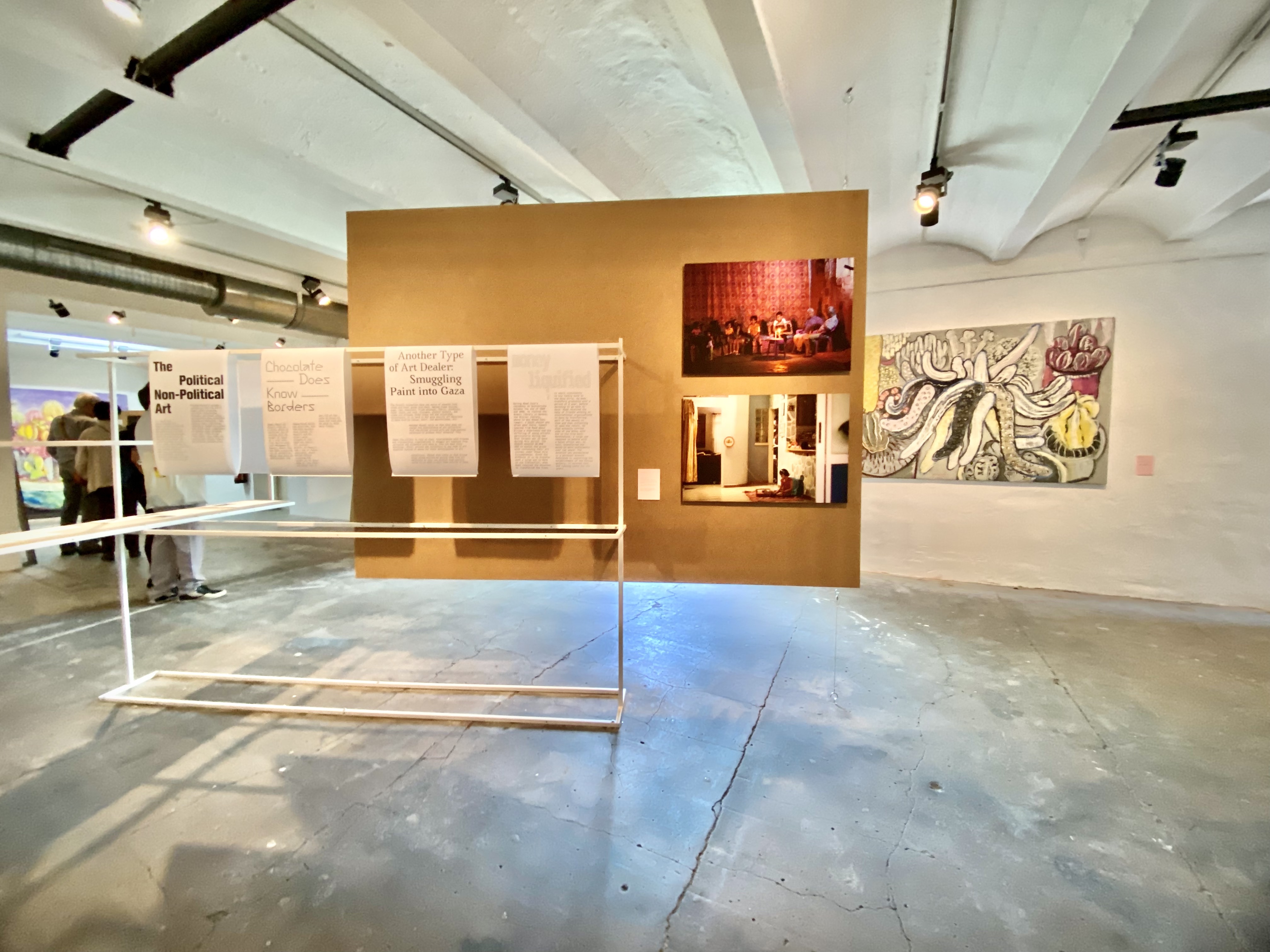
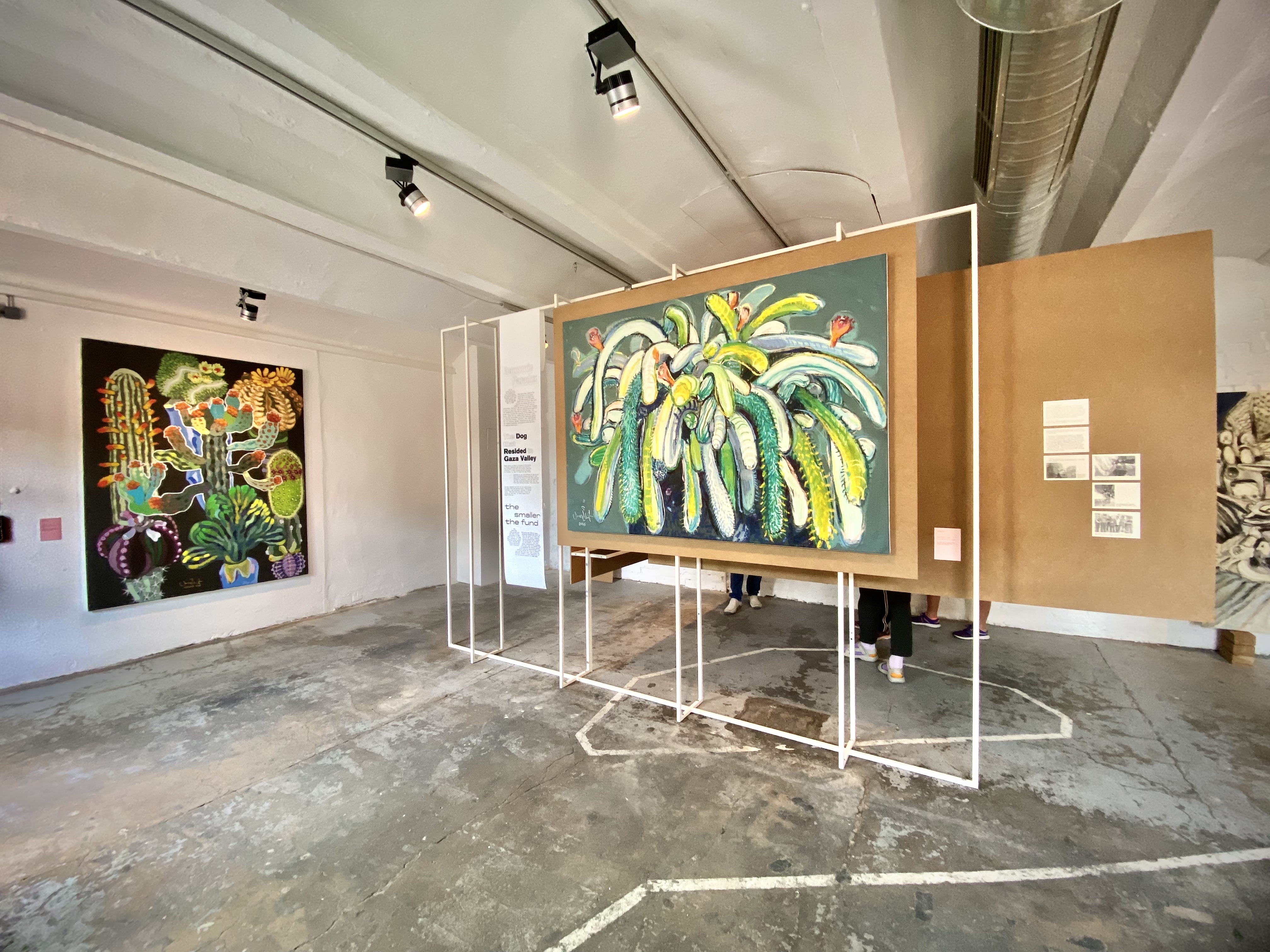
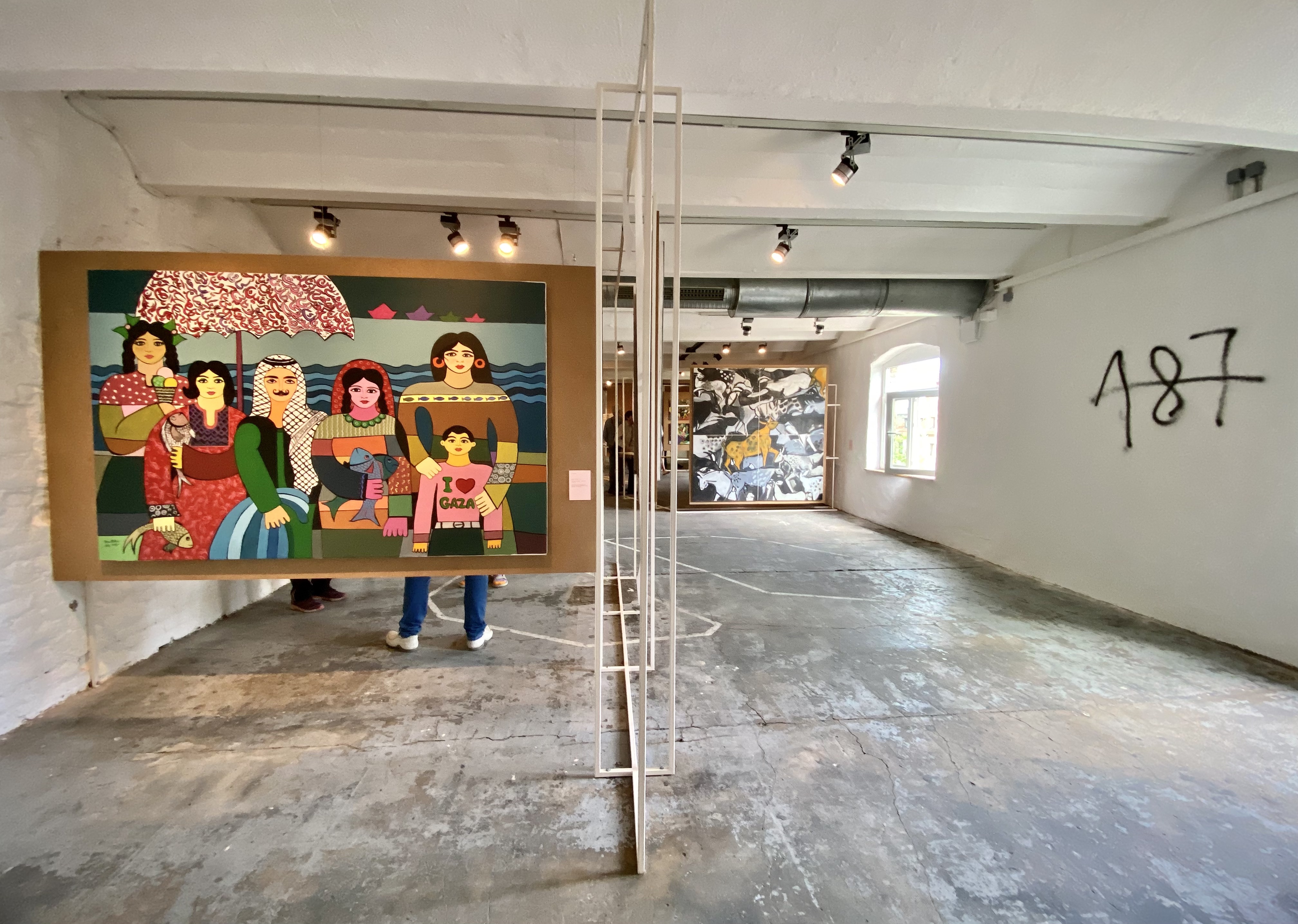
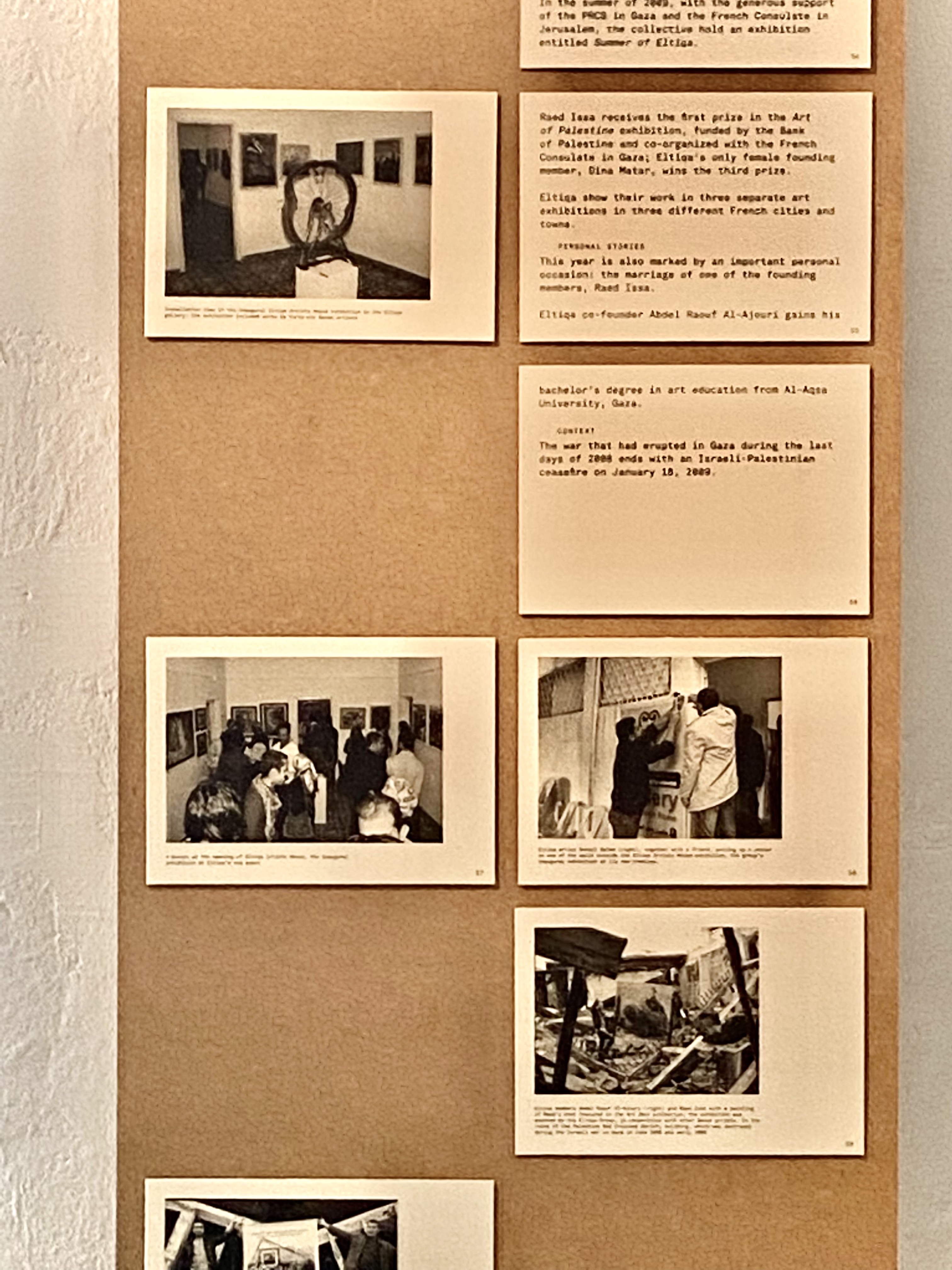


The harvest
Or how to extend knowledge beyond the limitation of the exhibition’s time and space?
Another key project at documenta fifteen that reflects our questions on economic and human resources takes the form of four books in which we explore issues related to labor, communal resources, and value through illustrated stories addressed to a young readership.
In this context, we worked closely and collectively with artists, illustrators, writers, and translators from Palestine, Lebanon, and the diaspora to develop fictional stories and narratives that explore these questions. How does one explain labor and exchange to children or a general readership? How is the economy tied to the land and how can it harness existing resources in a place like Palestine?
We call these stories harvests because they, in fact, harvest from our earlier questions to deploy others. There aren’t many books that attempt to talk about the economy in our context and we think it is important to foster a collective imagination of what possible futures might hold.
الحصادأو كيف نوسّع المعرفة إلى ما هو أبعد من حدود زمان ومكان المعرض؟
يعكس مشروع رئيسي آخر في documenta 15 أسئلتنا حول الموارد الاقتصادية والبشرية متخذاً شكل أربعة كتب نستكشف فيها القضايا المتعلقة بالعمل والموارد المجتمعية والقيمة من خلال قصص مصورة موجهة إلى القراء الشباب.
في هذا السياق ، عملنا بشكل وثيق وجماعي مع فنانين ورسامين وكتّاب ومترجمين من فلسطين ولبنان والشتات لتطوير قصص وروايات خيالية تسبر هذه الأسئلة. كيف يشرح المرء العمل والتبادل للأطفال أو لعموم القرّاء؟ كيف يرتبط الاقتصاد بالأرض وكيف يمكنه تسخير الموارد الموجودة في مكان مثل فلسطين؟
نطلق على هذه القصص تسمية الحصاد لأنها تحصد فعلياً من أسئلتنا السابقة لتبثّ أسئلة أخرى. لا توجد الكثير من الكتب التي تسعى إلى التحدث عن الاقتصاد في سياقنا ونعتقد أنه من المهم تعزيز المخيلة الجماعية لما قد يحمله المستقبل المحتمل.
A Book Like No Other aims to expand children’s perceptions about the wonders of producing a book with communal resources.
يهدف "كتاب ليس ككل الكتب" إلى توسيع أفق تصورات الأطفال حول عجائب إنتاج كتاب باستخدام موارد مجتمعية.
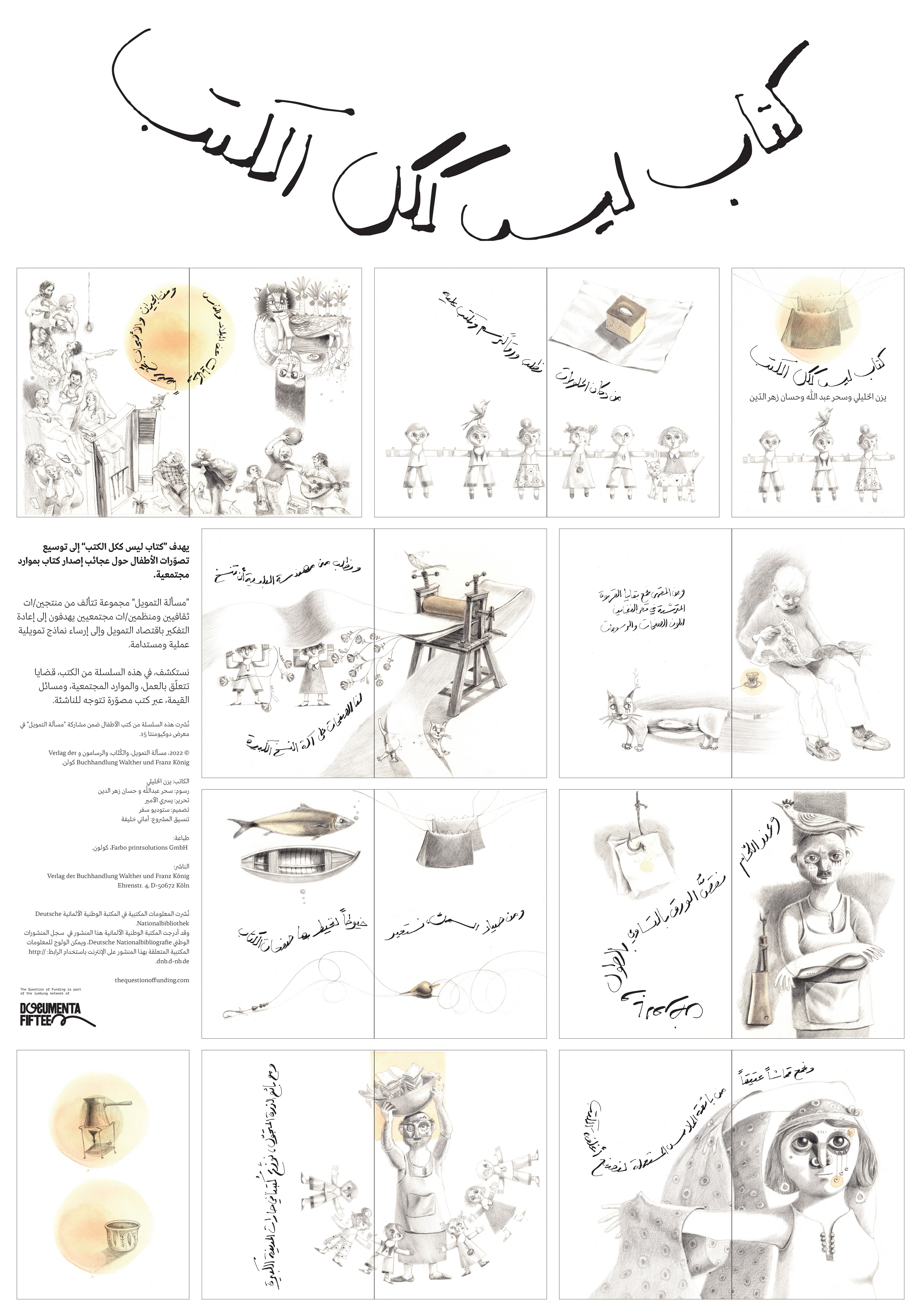
Written by: Yazan Khalili
Edited by: Yousri Al Amir
Illustrated by: Sahar Abdallah
Translated to English by Mona Kareem
Translated to German by Larissa Bender
Arabic handwriting by Yazan Khalili
Design by studio safar
كتبه يزن الخليلي
حرره يسري الأمير
وضعت رسومه سحر عبد الله
ترجمته إلى الإنجليزية: منى كريم
ترجمته إلى الألمانية: لاريسا بيندر
كتابة يد يزن الخليلي وتصميم ستوديو سفر
Lina and the Working Hands: We use our hands daily, sometimes without us noticing them. Yet their lines bear the marks of time and labor. Lina, a defiant nine-year-old girl, decides to follow the journey of the working hands around her, from the market to the house and the fields.
نستخدم أيدينا بشكل يومي، حتى من دون أن ننتبه لها أحيانًا، ومع ذلك تحمل أيدينا آثر الزمن والعمل. تقرر لينا، الفتاة الجريئة التي تبلغ من العمر تسع سنوات، أن تلاحق رحلات الأيادي العاملة حولها، من السوق إلى البيت فالحقول.

Written by: Samir Skayni
Edited by: Yousri Al Amir
Illustrated by: Hatem Imam
Translated to English by Mona Kareem
Translated to German by Larissa Bender
Arabic handwriting by Yazan Khalili
Design by studio safar
كتبه سمير سكيني
حرره يسري الأمير
وضع رسومه حاتم الإمام
ترجمته إلى الإنجليزية: منى كريم
ترجمته إلى الألمانية: لاريسا بيندر
كتابة يد يزن الخليلي وتصميم ستوديو سفر
The Gentle Asphalt I Deserved is the journey of a shoe that travels between different owners and classes. The story explores how the shoe’s value changes from one geography to the next.
يأخذنا "إسفلت لطيف كان يليق بي!" في رحلة حذاء تنقّل عبر السنين بين أرجل أناس من طبقات إجتماعية مختلفة. ترينا القصة تغيّر قيمة الحذاء عند انتقاله من جغرافية إلى أخرى.

Written and edited by: Yousri Al Amir
Illustrated by: Hassan Zahredddine
Translated to English by Mona Kareem
Translated to German by Larissa Bender
Arabic handwriting by Yazan Khalili
Design by studio safar
كتبه يسري الأمير
وضع رسومه حسان زهر الدين
ترجمته إلى الإنجليزية: منى كريم
ترجمته إلى الألمانية: لاريسا بيندر
كتابة يد يزن الخليلي وتصميم ستوديو سفر.
The Song of the Sea: The book is a story about fishing and the importance of inherited knowledge and local resources in economic production.
يحكي "أغنية للبحر" قصّة عن صيد الأسماك وأهمية المعارف المتوارثة والموارد المحلية في الإنتاج الاقتصادي.
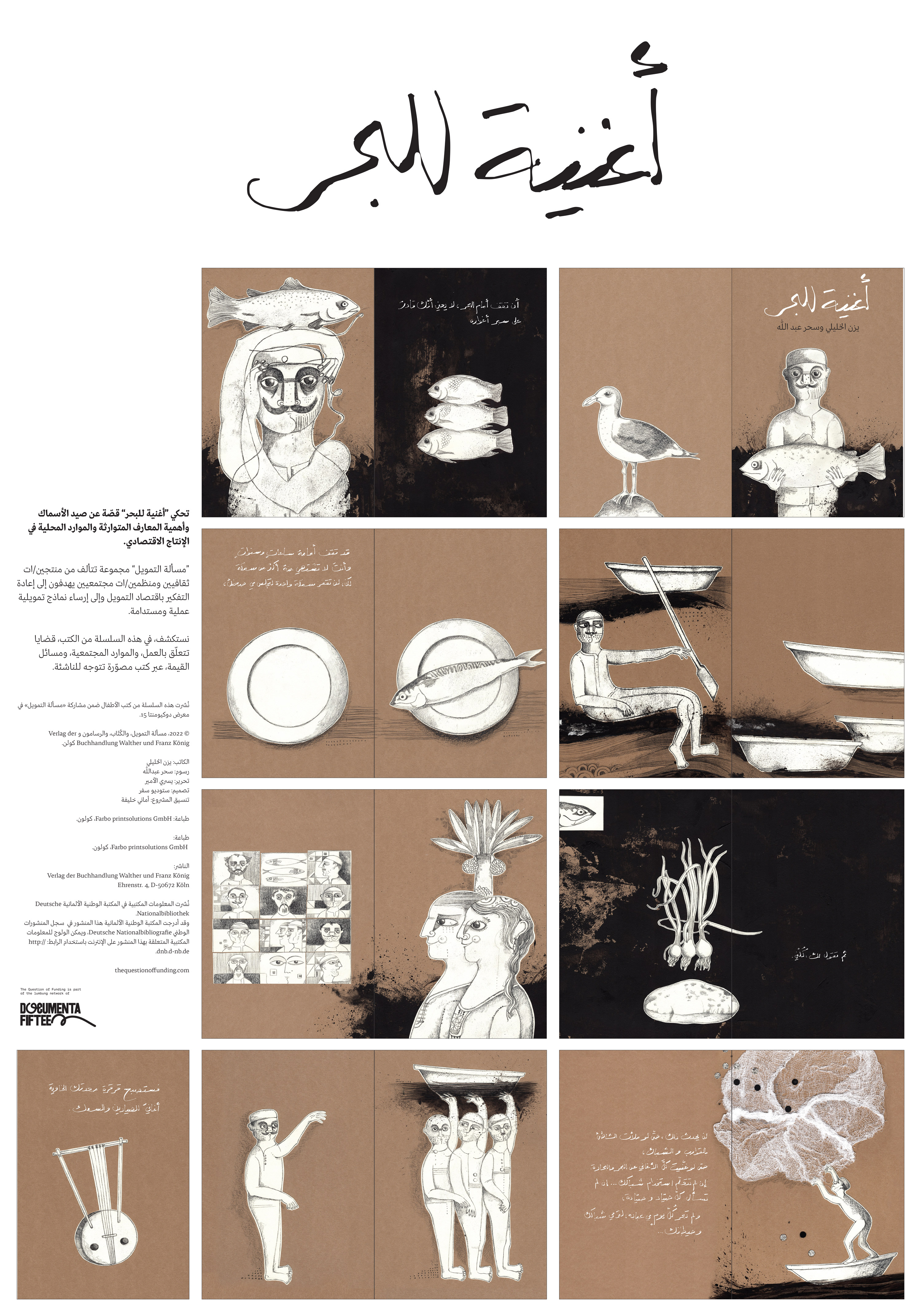
Written by: Yazan Khalili
Edited by: Yousri Al Amir
Illustrated by: Sahar Abdallah
Translated to English by Mona Kareem
Translated to German by Larissa Bender
Arabic handwriting by Yazan Khalili
Design by studio safar
كتبه يزن الخليلي
حرره يسري الأمير ووضعت رسومه سحر عبد الله
ترجمته إلى الإنجليزية: منى كريم
ترجمته إلى الألمانية: لاريسا بيندر
كتابة يد يزن الخليلي وتصميم ستوديو سفر
